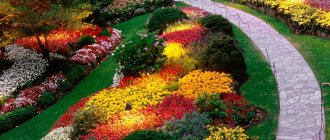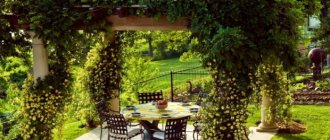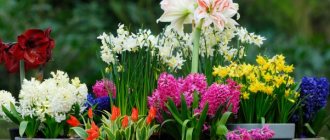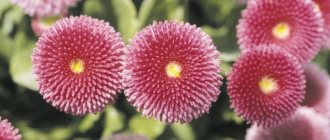Not always a garden plot can boast of having a large amount of free area for growing flowers or other plants. Often you have to look for secluded corners where certain crops are planted. Even if these areas are constantly in the shade, do not rush to get upset, because there are a large number of plants that feel great without direct exposure to ultraviolet rays. In this article we will look at perennial shade-loving flowers for the garden, their features and growing secrets.
Primrose
Wonderful low-growing perennial primrose and its hybrids thrive in the shade. They can grow at the front edge of the flower bed, in the shade of taller, sun-loving flowers. The height of shade-loving primroses is 10 - 20 cm, of various colors. The most interesting types of primroses to grow are auricular ones. Its flowers are double, with various rims. Primrose is difficult to grow at home from seeds, so most often they propagate by dividing old bushes, or purchase new ones. This flower is one of the first to bloom in the garden and delights with its flowering from April to May.
Coleus (Coleus scutellarioides)
Coleus varieties, popular for their colorful colors, vary in height from 20 cm to 80 cm. Although they produce beautiful blue to lavender leaves, they should be pinched to prevent stretching. Most coleus prefer morning sun and afternoon shade, but some coleus varieties (such as Wizard Velvet Red and Wizard golden) are more tolerant of heat and sunlight.
Lungwort
These flowers that love shade are familiar to many from childhood. It is the one that grows in the shade of the forest, and if you taste the bed of the peduncle, it will taste sweet. This is where the name of this color comes from. The leaves of this plant have white spots, the flowers change color from pink to blue. There are varieties with whole green leaves and varied flower colors. Plant height is 30 - 40 cm. It can grow strongly and is classified as ground cover flowers, since the flowers can bush a lot. Lungwort is divided and replanted once every 3 years. Refers to spring flowering plants. Flowering time: April - May.
Rogersia
It is similar to ornamental rhubarb and can grow in a shady, moist border. The leaves are palmate on long petioles, the flowers without petals are collected in fluffy panicles. It is a perennial and is propagated by dividing bushes in spring or autumn.
These are tall flowers that love shade in the garden, growing up to 1.8 m in height, compact plants up to 1 meter. An excellent plant for decorating country fences and buildings.
Tips for caring for Rogers:
- water abundantly during drought;
- In autumn, cut at the root.
Annuals
Without a doubt, shade-loving annuals, which women cannot do without, will also decorate any garden. After all, they have enough time to deal with seedlings and subsequent care for these fragile and delicate flowers. It goes without saying that there are much fewer of them than perennials, since most of them still require sun.
Shade-loving annual flowers:
- garden balsam (blooms all summer, until frost);
- annual begonia;
- calceolaria (most often grown as an annual flower, but can be left for the next year);
- saxifrage (from a botanical point of view, it is a perennial plant, but it does not tolerate winter well, so it is planted in gardens for only one year);
- gubastik (grown in rock gardens);
- molucella is smooth (exudes a strong odor);
- nemophila (delicate blue flowers similar to forget-me-nots).
Photo:
Annual flowers that tolerate shade well:
- Mexican ageratum (blooms from June until the first frost);
- marigold;
- cosmos;
- lobelia swollen (exudes the smell of tobacco);
- nasturtium;
- fragrant tobacco;
- fuchsia (belongs to perennial flowers, but in the fall gardeners prefer to remove it from the plots and replant it so that the plant does not die in winter).
Photo:
We must not forget that annual flowers need much more care than perennial flowers. Therefore, you need to constantly monitor the condition of the soil, water and feed them in a timely manner.
Smilatsina
A border perennial with arched stems crowned with racemes of tiny star-shaped flowers. Fragrant flowers are often replaced by red berries. This is a plant for a wooded corner of the garden that is best left undisturbed. And if you are deciding which flowers grow in shade, and forest-like shade, it is definitely smilacina, which grows quickly, forming beautiful ornamental bushes and creating a soulful landscape design for the area.
The height of the flowers is 60 - 90 cm. The best species for growing in the garden is Smilacina racemosus, which forms large bushes. Flowering period from May to June.
Tips for caring for smilacina:
- shading is required;
- in spring the soil needs to be mulched;
- propagated by dividing bushes in spring.
Design options for shady areas
Flower beds
Given the diversity of plants in size, height, flowering period and decorative value, designing flower beds becomes an enjoyable, creative activity with many different options. You can create a combined composition where the plants will bloom one after another or make a flower garden in which the main ones will not be flowering varieties, but with beautiful and colorful foliage. Imagine!
You can decorate and edge flower beds with small mounds of small pebbles, colored wood chips, mulch or decorative low fences, and sow lawn grass around them and pave paths.
Rock garden
Why not? Stones can be placed among flower beds, used as edging, or large specimens can be installed in different parts of the garden, decorated with smaller stones, and to prevent them from looking boring, unobtrusive grass perennials or ferns can be planted nearby.
Relaxation area and decorative elements
It is not at all necessary to arrange a leisure space with complex structures in a shady garden; a small table with a bench, a hammock or a simple small bench near a flowerbed will be enough. Garden figures and paths of various types, flowers in pots, etc. will be useful. The main thing is that the territory allows it.
Design of tree trunk circles
You can decorate the tree trunk area under three conditions: the tree must be mature and without surface roots; plants should not be planted too close to the tree trunk. For large trees with a lush crown and low-lying branches, it is necessary to select drought-resistant plants or plant early flowering species.
Well, some shade-tolerant vegetables and herbs can be added to the garden. For example, we often plant tomatoes to protect apple and pear trees from the codling moth. There are quite a few plants that can protect fruit trees from pests, for example, nasturtium will protect apple and cherry trees from apple worm and blood aphids, and daisies and marigolds will protect from aphids and nematodes. Lilies of the valley are a preventive measure against coccomycosis in stone fruit crops.
We study such properties of plants in practice and describe them on the pages of our website “ECOgarden for everyone”, because it’s so cool to use natural phytoncides to protect plants without resorting to chemicals.
There are many variations in the design of tree-trunk flower beds; they can be ordinary or multi-level; asymmetry and flower beds in the shape of a semicircle are welcome, especially if the trees grow along the wall.
A desolate area located in the shade can be turned into a fabulous, incredibly beautiful place. Use these tips and you will not have any questions about what to plant in the shade on your site.
Tiarella
Above the wintering leaves, which turn bronze or red in the fall, racemose inflorescences of small fluffy flowers rise in the summer. Grows well under trees.
Perennial. Flowering time depends on the species. Tiarella Verri blooms from June to September and does not spread. Tiarella multifolia blooms in May - June. According to the duration of flowering, these are long-blooming flowers. The height of the plants is average, 30 - 50 cm. These garden flowers, blooming in the shade, do not tolerate direct sun and lack of moisture.
There is one feature for all flowers in the shade - all shade-loving flowers need to be planted on humus-rich soil.
Dicentra
An excellent border perennial and rock garden perennial with a plant height of 30 cm. Wonderful medallion flowers hang from arched peduncles above the feathery foliage. These shade flowers need a protected place to grow: young leaves suffer from cold winds. These flowers can be planted in the shade of trees. Flowering time is from May to June. Color: pink, pinkish-lilac, red.
Dicentra care advice:
- The roots of the plant do not lie deep, so the soil around the stems is not loosened.
Red Horny Goat Weed
Red mountain weed (Epimedium rubrum) forms a dense, neat carpet right around tree trunks.
Young leaves look very bright, and in May, reddish flowers of unusual shape add color. Red mountain weed (Epimedium rubrum) You will find more information about mountain weeds in the publication What attracts us to mountain weeds: a portrait of a shade-loving plant.
Khosta
Hosta is grown for its gorgeous foliage. These are decorative leafy garden flowers in the shade - the pride of any gardener. The foliage has longitudinal stripes of yellowish or white color, bluish-green. Hosta blooms in paniculate inflorescences, with numerous bell-like flowers that bloom in June - August. Grows well in partial shade, under trees. Belongs to border perennials.
Propagated by dividing bushes and nests in the spring. Plant height 50 cm.
Hosta care tip:
- add organic matter before planting;
- the soil where the hosta is planted should be well-drained;
- protect the plant from slugs.
Best plants for dry shade
Perennials:
- Aquilegia (catchment)
- Fischer's aconite (fighter)
- Autumn anemones
- Asperula (woodruff)*
- Bergenia (bergenia)
- Basilisk
- Heuchera
- Geraniums
- Goryanka
- Dicentra (broken heart)
- Creeping tenacious
- Iris stinking
- Kopyten
- Crocosmia (Montbrecia)*
- Lily of the valley
- Lunnik
- Cuff
- Lungwort
- Myrris fragrant
- Euphorbia almond
- Hellebores (helleborus)
- Foxglove (digitalis)
- Forget-me-nots
- Comfrey
- Sedge, sedge and other cereals*
- Spring primrose and common primrose
- Khosta
- Chistets woolly
- Yasnotka
Shrubs:
- Wolfberry (daphne)
- Wintergreen (Pernettia) pointed
- Deytsia
- Keria japonica
- Mahonia holly and creeping
- Sarcococcus
Spring bulbous:
- Anemone
- Hyacinth
- Hyacinthoid
- Kandyk
- Muscari
- Narcissus
- Snowdrop
- Scylla
Autumn bulbous:
- Colchicum*
- Liriope
- Cyclamen neapolitanis
Violet
There are different types of violets, which are also called pansies. But, if you are choosing a list for the garden, from the category of which flowers bloom in the shade, then you need a perennial violet. This:
- Fragrant violet Viola odorata - 10 - 15 cm. White or blue color. Fragrant. Flowers with a diameter of 2 cm. Blooms in May.
- Horned violet Viola cornuta - 20 cm. Lilac. Blooming all summer from May to September.
- Labrador violet Viola labradorica - 10 cm. Violet - blue. Blooms in spring and early summer.
- Yellow violet Viola lutea and two-flowered Viola biflora - 10 cm. Yellow. Blooms in May - June.
Perennial violets definitely need shade. Faded inflorescences should be removed regularly. The plant is protected from slugs. During drought, watering is necessary.
Phloxes
There are perennial and annual phloxes. And both types are the kind of flowers that love light shade. They bloom profusely in the second half of summer. Dwarf perennial phlox species are grown in rock gardens.
Phlox blooms in inflorescences of small bell-shaped flowers, the total size of the inflorescences reaches 10 cm in diameter. Flowers with rounded or pointed petals. More popular modern varieties such as Phlox Drummond 'Tapestry Mixed' are more compact and more vibrantly colored than older varieties. The height of perennial plants is 50 - 80 cm, annual phlox reaches 20 - 50 cm.
Phlox care:
- when planting, add organic fertilizers to the soil;
- in spring, the soil around the bushes is mulched;
- if necessary, tie up the stems;
- water moderately;
- at the end of autumn, perennial phloxes need to be cut off at the root.
Fuchsia (Fuchsia spp)
Fuchsias come in a variety of sizes and shapes, with single or double, often bicolor flowers that sway like dangly earrings. The genus Fuchsia has more than 100 species! Although many gardeners grow these plants as annuals, they are actually tender perennials that can survive in warm climates and, with proper care, can overwinter in colder zones.
Fuchsias do not like wet weather and will wilt if exposed to direct sunlight or too high a temperature. They bloom best in moist soil and some morning sun.
Astilbe
Feels great in light partial shade on the site. Requires fertile soil. Therefore, before planting astilbe, you need to add organic matter. Spectacular paniculate inflorescences can be left on the bush until autumn. Pinnately dissected leaves often take on a copper tint in spring. During drought, plants need to be watered. There is a drought-resistant species - this is Chinese astilbe.
A fairly tall plant - 90 cm, can grow in the background or middle ground of a flower bed. Used as a border perennial and rock garden perennial. These flowers need to be planted in the shade.
Kochedyzhnik
Scalloping ferns (Athyrium), forest ferns with lacy leaves and thick rhizomes, thrive in dry shade under trees.
The most commonly grown plants are female (Athyrium filix-femina) and nippon (Athyrium niponicum), which are spectacular already in the spring, when the fronds are just unfolding. Nippon nomadic fern (Athyrium niponicum) We have already written about nomadic ferns and other ferns in the articles:
- Fan leaves: types of ferns and their features
- Perennials with beautiful leaves: where to plant them and how to care for them
Snowdrop
Bulbous primrose. Small graceful flowers are the harbingers of spring. It blooms in early spring, one of the first in the garden, in April - May.
The snowdrop is similar to the whiteflower, but it has three inner "petals" with green tips, and the outer three are pure white. A low-growing flower, about 15 - 20 cm in height. Loves humus-rich soil and light shade. These lovely flowers need to be planted in the shade.
Ideas for decorating a flower bed in the shade
When planting shade-tolerant annuals in a flower garden, you should follow several rules:
- tall, large plants are placed in the background or in the center - the upper tier;
- shorter crops – middle tier;
- ground-blooded and creeping annuals are placed on the lower tier.
Shade-tolerant crops, as a rule, are distinguished by their original shape and texture of leaves. Therefore, they should be combined with bright colors.
Advice! In summer, flowering annuals can be planted in place of faded bulbous flowers.
Strawberries
A shade-loving groundcover plant grown for its flowers and berries. The characteristic trifoliate leaves can decorate a shady garden and create an atmospheric corner.
Strawberries grow quickly and can choke out weaker plants. It blooms in May - June, and the delicious and fragrant berries ripen at the end of June - July. Suitable for creating a herb garden. Plant height 10 cm - 20 cm.
catchment area
Traditional columbines have white or blue flowers with short spurs. Nowadays varieties with long spurs, double varieties, and also dwarf ones for rock gardens have been bred.
These are flowers that love shade and bloom in the shade in the first half of summer, from May to June. For long-term flowering, you need to remove faded flowers and water abundantly during drought. They grow well in constantly moist and shady places.
They reproduce by seeds, which can be sown directly into open ground in the spring or by dividing overgrown perennial bushes.
Spectacular summer shade-tolerant flowers for partial shade
- Daylilies are showy plants with large, fragrant flowers. Abundant flowering directly depends on lighting, but in nature it grows in partial shade. Flowering duration is no more than one month.
Daylilies
- How do you know if a daylily likes shade or sun ? Ideal placement for a flowering flower bed is partial shade. Bright colors fade in the sun, so dark shades should definitely be placed in the shade. Daylilies look impressive when planted densely and separately from other flower arrangements . Summer flowers can be planted under vineyards and fruit trees.
- Pansy is an annual plant most often found in sunny flower beds. To prolong the flowering of a summer plant, it is better to choose an area with partial shade. Shade-tolerant flowers for the garden will be smaller in size, but will not lose their colors.
Should be planted in partial shade
- Pansies are propagated vegetatively or wait until the flowers are sown on their own. The plants bloom throughout the summer and are very reminiscent of homemade violets.
Note: A garden plot with partial shade should be illuminated by the sun for at least 3 hours a day, which falls in the morning or evening.
- Delphinium is a summer flower with tall peduncles of variegated shades. The plant is planted both in the shade and in the sun. Does delphinium like shade or sun ?
Bright delphinium
- In strong sunshine, the petals burn out, which shortens the flowering period. The best place for planting delphinium will be the side where contact with the sun's rays occurs in the first half of the day. The first flowering occurs in June-July. When pruned correctly, the plant produces flowers again.
- Impatiens is an unpretentious summer plant with long flowering. The fleshy stems bear dense, green, pointed leaves. Large flowers are placed from bottom to top on a vertical arrow. They come in red, purple and white.
Balsam
- Impatiens does not tolerate direct sunlight and frost. Feels comfortable in partial shade. In the Southern States of America the plant blooms all year round. Inside the flower there is a fruit-box with seeds, which are easily removed upon contact.
Looks great in the garden
- Astrantia are perennial summer flowers that love shade , sun and partial shade equally. An unpretentious plant blooms in any soil and, with sufficient quantity, forms powerful bushes.
Blooms for quite a long time
- Due to its versatility, astrantia is actively used by designers for landscaping areas. Single-colored inflorescences persist throughout the summer and retain their appearance for a long time after cutting.
- Phlox are dwarf perennial flowers that love partial shade. Dense inflorescences bloom abundantly in mid-summer. Bush phlox flowers are painted in bright rich colors and emit a pleasant fragrance. Popular colors include red, white and purple. When exposed to sunlight, the flowers glow with their colors.
Bright summer flowers
- Summer phloxes tolerate replanting well even during flowering and quickly reproduce through division of bushes. With a lack of moisture, the leaves quickly turn yellow and the flowers become smaller.
- Cosmea is an unpretentious herbaceous plant with a lot of greenery. The daisy-shaped flowers are painted in a rainbow of pink and white colors. Terry varieties are colored burgundy and yellow.
Bright flower
- After flowering, the densely planted shoots of cosmos resemble a fluffy carpet. Separately planted flowers stretch up to 1.5 m in height. Blooming cosmos tolerates cold well and grows equally in both shade and sun. Partial shade is ideal for this plant.
- Viscaria - summer flowers for partial shade . The low plant has underdeveloped foliage, which during the flowering period is completely covered by flowers with delicate shades of pink and blue.
Viscaria
- A climbing plant is often used to decorate gazebos and balconies. The flowering period is two months. Unpretentious viscaria does not require additional feeding, but does need regular watering.
We advise you to read interesting articles about flowers:
- What flowers to plant along the fence
- What plants, flowers, trees and shrubs bloom in early spring before the leaves bloom
- The most beautiful flowers in the world
- What unpretentious flowers should I plant on the balcony on the south and north sides?
- What flowers are best to plant on the balcony in summer and winter?
Day-lily
Blooming in light shade, these flowers appear in midsummer, above rosettes of strap-shaped leaves on long stalks. Each flower lives only 1 day, but the flowering communication of the plant continues for many weeks.
An unpretentious, easy to grow plant. Requires watering during drought, can grow along the banks of reservoirs and along the house. Plant height is 90 cm. Flower color is yellow, orange, dark red. A perennial plant that reproduces by dividing bushes.
Begonia everblooming and begonia species with tubers
Begonia is an ever-blooming plant, usually grown as an annual that grows well in partial shade. The color of the round, fleshy leaves varies from pale green to chocolate brown. The size of flowers can vary from 2 to 15 cm. Color from white to almost black. When planting begonias, add compost to the beds. Planted at the end of June (not in May!) Begonia blooms, which loves shade from June to September.
Ivy
Almost every summer cottage could use climbing plants for the north side of the house. It is here that a deep shadow forms, little grows, and despite this, I really want to green up this particular part of the lot. There are not many climbing plants that can be planted on the north side of the house and they will do well there. This is exactly what the unpretentious evergreen vine, ivy, belongs to. Ivy does not harm trees or buildings and can grow wildly.
Sweet potato (Ipomoea batatas)
Although related to Convolvulaceae, the ornamental vine species Ipomoea sweet potato rarely flowers. But their wide variety of varieties allows you to choose heart-shaped or lobed leaves in almost any color you prefer, including black, red, chartreuse and variegated. These colors are most intense in full sun but can be stunning in partial shade. Although the roots of the ornamental sweet potato morning glory are edible, they are not very tasty.
What shade-loving flowers do you grow in pots on your terrace? Share names and experiences in the comments! If you liked the article, share it with your friends on social networks!
Andreeva Tatyana. Freelance writer











